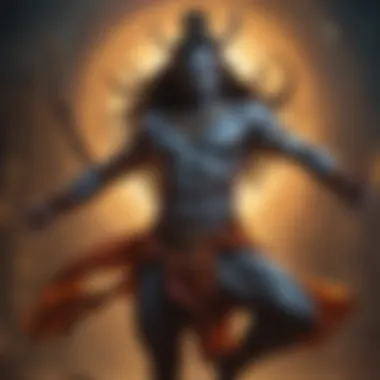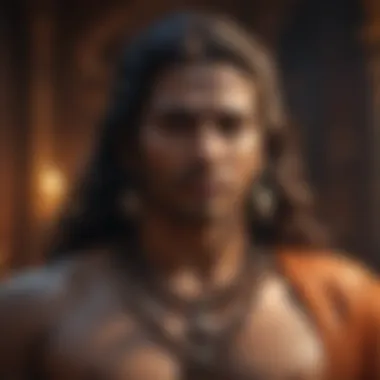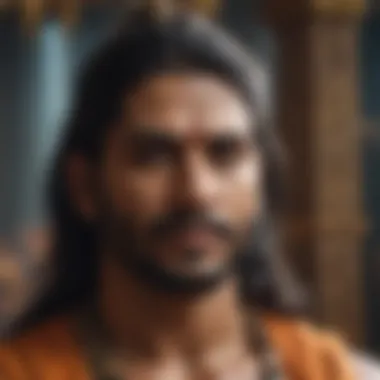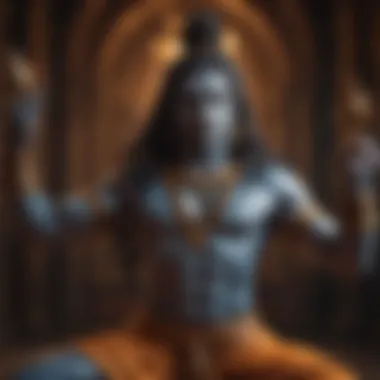Shiva Tandava Stotram: A Deep Dive into Its Significance


Intro
The Shiva Tandava Stotram is not just a piece of devotional literature, but rather an exquisite portrayal of the boundless energy associated with Lord Shiva. This stotra encapsulates the very essence of creation and destruction, mirroring the cosmic dance that embodies the cycle of life itself. It's a prayer that resonates deeply within the hearts of devotees and offers a glimpse into the philosophical underpinnings of Hindu spirituality.
To dive into this, we will explore the origins of the stotram, the intricate structure of its verses, and the metaphysical insights that it lends us. As we peel back the layers, you will find that the Shiva Tandava Stotram serves not only as an invitation to reverence but also as a catalyst for personal and collective spiritual evolvement.
Our journey will traverse the historical narratives that brought this stotra to life, its linguistic richness that transcends mere words, and the relevance it holds in contemporary spiritual practices. By examining these facets, our aim is to provide a holistic understanding of the text, which stands as a monument of devotion and philosophical inquiry.
Through each section, we eagerly anticipate shedding light on the deeper implications of this work, its beauty, and its impact. By the end of this exploration, you will not only appreciate the lyrical quality of the stotram but also feel its profound significance embedded in the cultural fabric of spirituality.
Preface to Shiva Tandava Stotram
Shiva Tandava Stotram is not merely a collection of verses; it embodies a profound spiritual essence that resonates deeply within the fabric of Hindu cosmology. This stotra highlights the magnificent cosmic dance of Lord Shiva, a deity who transcends mere worship to represent a dynamic force of creation and destruction. Understanding the importance of this piece in the realm of devotional literature is paramount for anyone seeking to grasp the complexities of Hindu spirituality and culture.
At its core, Shiva Tandava Stotram serves a dual purpose: it acts as both a meditation on the nature of divinity and a guide for aspirants seeking spiritual elevation. The rhythmic verses invoke a sense of awe and reverence, inviting practitioners to explore the philosophical depths underlying the dance of creation and dissolution. Engaging with the stotra encourages introspection, making it a timeless practice for enhancing one's spiritual journey.
Historical Context
The origins of Shiva Tandava Stotram can be traced back to ancient scriptures, a time when oral traditions thrived. Traditionally attributed to Ravana, the demon king of Lanka, this stotra is a testament to his immense devotion toward Shiva, showcasing that even beings seen as adversaries can attain deep spiritual insight. The narrative surrounding its composition reflects broader cultural dynamics too, where ancient texts often serve as bridges connecting the spiritual with the mundane.
Shiva's tandava, or dance, is fundamental in Hindu mythology; it symbolizes not only destruction but also renewal. Thus, understanding the historical context of the stotra sheds light on its enduring relevance. This section will elaborate on key events and milestones that shaped its journey, allowing readers to appreciate the layers of significance embedded in the stotra.
Cultural Significance
Culturally, the Shiva Tandava Stotram offers insights into artistic expressions ranging from rituals to performance arts. This stotra is often recited during auspicious ceremonies, wherein devotees seek blessings and divine guidance. The rhythmic chant enhances a sense of community while echoing the timeless narrative of Lord Shiva as the cosmic artisan.
Moreover, the stotra has staked its claim in various art forms, including classical dance. For instance, the intricate movements of Bharatanatyam often draw inspiration from its verses, depicting Shiva’s tandava in vivid ways. Each performance can turn into a living testament of faith, weaving spirituality into the very fabric of daily life.
In essence, the cultural significance of the Shiva Tandava Stotram extends beyond recitation into a celebration of diverse interpretations and expressions that have evolved over centuries. It encapsulates the essence of transcending individual experience, creating a collective tapestry woven with devotion, artistry, and history.
"Shiva Tandava Stotram is the pulse of devotion, echoing through ages and across cultures, a call to both celebrate and reflect upon the cosmic dance within us all."
Thus, integrating historical insights and cultural narratives surrounding the stotra lays a strong foundation for understanding its rich and multifaceted legacy.
The Structure of Shiva Tandava Stotram
The structure of the Shiva Tandava Stotram is quite important to understanding its essence. Its design is not merely an aesthetic choice but serves to elevate the devotional experience. This section will unravel the intricate layers of the Stotram, focusing on its verse composition and linguistic elements, which together contribute to its rich spiritual and philosophical depth.
Verse Composition
The Shiva Tandava Stotram is composed of seventeen verses, each resonating with potent imagery and vivid descriptions of Lord Shiva's cosmic dance. Traditionally attributed to Ravana, the demon king of Lanka, who was also an ardent devotee of Shiva, the verses are often regarded as a devotion rather than just a poetic endeavor.
Each verse intertwines rhythm and meaning. The meter primarily follows a rhythmic pattern – the Anushtubh meter, which is widely used in classical Sanskrit poetry. This choice isn’t arbitrary; it serves to facilitate recitation and intensifies the devotional experience. As one articulates each line, the sonic quality seems to echo the very rhythms of the universe that Shiva embodies. The alternating cadence engenders a sense of balance akin to the cosmic order that Shiva presides over.


Moreover, the thematic richness of the verses often oscillates between worship, fear, and devotion. For instance, the glorification of Shiva’s terrors of destruction intertwines seamlessly with the heartfelt praises of his benevolence. This duality forces one to confront and embrace the diverse aspects of divinity.
Linguistic Elements
The linguistic elements of the Shiva Tandava Stotram amplify its appeal, delivering deeper meanings layered within the text. Its language, though ancient, is a testament to the Sanskrit's beauty. The use of metaphors and imagery within the Stotram paints a vivid portrait of not just Lord Shiva but the entire cosmos.
Words chosen are not merely descriptive; they evoke feelings and emotions. For instance, descriptors like "Tandava" denote the vigorous dance of Lord Shiva, evoking feelings that mingle between awe and reverence. Other terms, such as "Bhava", translate loosely to existence or being, indicating the essential nature of life and the universe. Such linguistic choices provide a profound insight into the nature of Shiva's presence in our lives.
Additionally, the alliteration and assonance in the verses create a musicality that enhances the overall recitation experience. The seamless flow of sounds draws one in, making it a practice not just of reading but of participatory devotion. When recited correctly, one almost feels the vibrations of the universe harmonizing with their inner being.
In summary, the structure of the Shiva Tandava Stotram encapsulates the intersection of art and spirituality, portraying a cosmic saga through its verse composition and linguistic elements. Each segment serves as a reflection of divine attributes while guiding devotees toward spiritual awakening. The careful crafting of this Stotram ensures that it remains a cornerstone of Hindu devotional literature, carrying timeless significance even in contemporary settings.
Philosophical Themes
The Shiva Tandava Stotram intertwines deep philosophical themes that captivate the minds of those who delve into its verses. These themes not only highlight the magnificence of Lord Shiva but also evoke thoughts about the nature of existence itself. As one navigates through this stotra, it becomes clear that the philosophical undercurrents serve as a bridge between divine principles and human experience, making it a prominent aspect of spiritual exploration.
Cosmic Order and Chaos
The dynamic interplay of order and chaos resonates profoundly within the stotra. In many ways, Shiva embodies this duality. While he is often seen as the destroyer, his destruction paves the way for new beginnings. This aspect prompts readers to ponder the life cycles that govern their existence; in every end lies the seed of a new beginning. For instance, when witnessing natural disasters or personal upheavals, understanding Shiva’s role in cosmic dance can provide solace.
Shiva’s Tandava dance symbolizes not just devastation but also renewal. This idea echoes in various philosophical teachings around the world, where chaos is viewed as a necessary precursor to transformative order.
It prompts the questing spirit to ask:
- How does chaos shape my journey?
- What new paths emerge from my struggles?
"In the chaos of life, the essence of creation whispers the promise of rebirth."
Creation and Destruction
The themes of creation and destruction in Shiva Tandava Stotram are intertwined like threads in a tapestry. The profound realization that destruction is not merely an end but is essential for creation challenges conventional perceptions. There’s a philosophical elegance in recognizing how destruction often serves a purpose — as the old makes way for the new.
In various spiritual practices, the cycle of creation and destruction is also emphasized. Many traditions argue that understanding this cycle can liberate individuals from fear of change. Letting go of the old can be transformative, as it opens up space for new experiences, relationships, and insights.
- Shiva’s dance encapsulates this duality:
- Through the destruction of ignorance, enlightenment can be birthed.
- The cycle compels individuals to embrace life’s fleeting nature, steering them towards deeper realizations.
The Nature of Divinity
The Shiva Tandava Stotram does not just portray Shiva as a deity but also invites contemplation of divine nature itself. What does it mean to be divine? The stotra encompasses various aspects: from the fierce to the nurturing.
Shiva’s multifaceted character invites followers to explore their deeper selves and understand their inherent divinity. Are we not, in essence, reflections of what we worship?
This concept connects with many spiritual philosophies that advocate for self-realization as a means to understand the divine. Recognizing the divinity within can lead to a more profound connection with the universe and foster compassion for others.
As seekers of truth, one may ask themselves:


- In what ways do I embody divinity?
- How can I connect more profoundly with the cosmic energy around me?
This reflective inquiry can pave the way toward a grounded spirituality that seamlessly marries the mystical with the mundane.
The Dance of Shiva
The concept of the Dance of Shiva is intricately woven into the larger tapestry of the Shiva Tandava Stotram. This dance, known as Tandava, serves not just as a representation of Lord Shiva's cosmic energy but also encapsulates deeper meanings that resonate with both spiritual and cultural practices. The Tandava is not merely a dance; it is a profound expression of the eternal cycles of the universe, symbolizing creation, destruction, and renewal — the very essence of existence.
The importance of understanding the Dance of Shiva lies in grasping these broader themes and appreciating the rituals and artistry that have evolved around them.
Symbolism of Tandava
Tandava epitomizes the duality of existence — it combines fierce energy with sublime transcendence. In many traditions, Shiva's dance is seen as a catalyst for the creation and destruction of the universe. The vigorous movements reflect the forceful nature of destruction, while the graceful flow suggests the beauty of creation. This dynamic interplay is essential in interpreting the stotra as it emphasizes the cyclical understanding of life.
- Cosmic Duality: Each move represents harmony in chaos. The rhythm of Tandava captures the undying flow of energy within the cosmos, where every end births a new beginning.
- Divine Emotions: It reflects the emotional states of bliss and anguish, linking the divine with human experience. These sentiments draw the devotees closer into an intimate communion with the deity.
This powerful dance resonates deeply with practitioners, serving as both a reminder and a method through which devotees can engage with the transformative forces of nature and divinity.
The Tandava is a reminder that our lives are composed of cycles — the pulsation of joy followed by sorrow, death intertwined with rebirth.
Ritualistic Practices
Rituals surrounding the Dance of Shiva vary widely across cultures and regions but often aim to invoke Shakti, the divine energy. Engaging in Tandava-related practices plays an important role in spiritual gatherings and personal devotion.
- Chanting and Movement: Participants might recite the Shiva Tandava Stotram accompanied by rhythmic body movements that mimic the dance itself, creating an immersive experience.
- Fire Offerings and Meditations: Traditional rituals often involve fire, symbolizing transformation. Devotees might meditate while visualizing their connection to the cosmic energies embodied in Shiva’s dance.
This practice not only solidifies their engagement with the divine but also inspires a deep, nearly physical connection with the metaphysical themes present in the stotra.
Artistic Representations
Artistic expressions of the Dance of Shiva bring to life the rich legends and meanings embedded within the Tandava. From ancient sculptures to contemporary performances, these representations elevate the significance of the dance.
- Sculptures & Temples: Statues of Shiva performing Tandava can be found in ancient temples, showcasing intricate designs that capture the movement and energy of the dance as it was envisioned by craftsmen of yore.
- Dance Forms: Classical Indian dance forms, like Bharatanatyam and Kathak, often include sections that depict the Tandava. This results in an atmospheric dialogue between body and spirituality, where every gesture encapsulates a philosophy.
In these artistic representations, the essence of Tandava transforms into visual and performative art, allowing devotees and audiences alike to engage with its profound, underlying messages in a multisensory manner.
Engaging with the Dance of Shiva through these layers of symbolism, ritual, and art enriches our understanding of the Shiva Tandava Stotram. It opens up pathways for deeper reflection on the cycles of life and the cosmic forces at play, encouraging practitioners and audiences to find meaning not only in the movements but in their own lives.
Recitation and Contemplation
The recitation and contemplation of the Shiva Tandava Stotram hold immense importance within the broader context of spiritual practices. It is not merely about chanting verses; it encompasses a deep engagement with the text that nurtures the spiritual self. Engaging with this ancient stotra can foster a unique connection to both the divine and the cosmic rhythms of the universe itself.
When a practitioner recites the stotra, they engage in a form of puja that goes beyond the physical acts of worship. It is about immersing oneself in a vibrational frequency that has empowered practitioners for centuries. Many individuals experience a profound transformation, as the verses of the stotra echo in their hearts, resonating with their innermost thoughts and emotions. This process is integral to realizing the Tandava's essence, as it encapsulates not only the actions of Lord Shiva but also the cosmic forces that govern life.


Benefits of Recitation
Reciting the Shiva Tandava Stotram manifests profound benefits, ranging from mental clarity to spiritual elevation. Here are several key advantages:
- Calming the Mind: Chanting these verses can bring tranquility to the chaotic thoughts that often plague daily life. The rhythmic flow of the words can act like a balm for the restless mind.
- Enhancing Focus: The act of recitation calls for attention, allowing practitioners to sharpen their focus. This concentrated mindfulness can lead to improved cognitive abilities and a greater sense of presence.
- Spiritual Connection: Developing a personal connection with Lord Shiva becomes more potent with each recitation. Many devotees report feelings of peace and protection during and after the chanting.
- Purification of the Soul: Regular recitation aids in cleansing negative energies and clearing emotional blockages. It fosters a spiritual renewal that can significantly enrich one's life's journey.
- Emotional Release: Like a conductor leading an orchestra, articulate expression through recitation allows hidden emotions to surface, enabling cathartic releases that can be healing.
The spiritual benefits of recitation extend beyond individual practice; they contribute to communal harmony and universal connectivity.
Meditative Practices
Meditation serves as an essential counterpart to the recitation of the stotra. They are like two sides of the same coin, each enhancing the other. Meditative practices involving the Shiva Tandava Stotram can take various forms:
- Focused Listening: Instead of actively reciting, listening to a skilled reciter can foster deep meditative states. This allows one to absorb the vibration without the distraction of enunciation.
- Visualization: While reciting, practitioners can visualize Lord Shiva in the act of performing Tandava, symbolizing destruction and creation. This imagery can evoke powerful sensations and personal insights.
- Breath Integration: Synchronizing breath with the rhythm of recitation can deepen the meditative experience. Using slow inhalations and exhalations while chanting allows for a harmonization of body and mind.
- Journaling Reflections: After recitation, journaling your thoughts and feelings about the experience can uncover deeper layers of understanding about oneself and the cosmic truths embodied in the stotra.
In essence, the act of reciting the Shiva Tandava Stotram can be a rich avenue for introspection, spirituality, and mental clarity. It serves as a bridge connecting the individual to the profound, reminding us of the balance between chaos and harmony that permeates life.
Contemporary Relevance
The modern world constantly searches for meaning and depth amid chaos. In this context, the Shiva Tandava Stotram serves as a rich tapestry, weaving together ancient philosophies and contemporary existential questions. It is not merely a historical relic but a living scripture that resonates with the spiritual currents of today. The rhythmic verses echo the duality of life, embodying both creation and destruction—a theme that is particularly poignant in our fast-paced lives.
One key aspect that stands out in today’s context is how the stotra influences personal spiritual practices. Many individuals, drawn to its robust imagery and profound metaphysical themes, have incorporated its recitation into their daily routines. It’s a way to connect the mundane with the divine, an act of grounding that invites contemplation. By chanting these powerful verses, seekers recapture a sense of balance in their lives, fostering inner peace amid the tumult.
Moreover, the Shiva Tandava Stotram plays a role in modern spiritual communities, often cited in workshops and retreats focused on self-exploration. The asanas and meditative practices centered around its themes foster a communal sense of connectedness and shared understanding.
Impact on Modern Spirituality
The exploration of spirituality in the modern era often grapples with the question of authenticity. The Shiva Tandava Stotram is cherished for its genuine portrayal of divine complexities. It emphasizes the integration of opposites—creation and destruction, joy and sorrow, chaos and order. Such themes resonate with practitioners seeking to understand their multifaceted existence.
- Personal Transformation: Many find that engaging with the stotra leads to self-reflection and transformation. The confrontation with one's inner chaos and subsequent journey towards self-discovery aligned with Shiva’s dual nature inspires individuals to embrace their journey authentically.
- Community Building: Reciting this stotra often brings together groups of devotees who seek a shared spiritual experience, creating bonds rooted in collective belief and ritual practice.
- Technological Integration: Today, mobile apps and online platforms allow devotees to access audio-visual guides for recitation, making the practice more accessible. This blending of technology and tradition is a testament to the stotra's relevance in the digital age.
Influence on Popular Culture
The Shiva Tandava Stotram has permeated popular culture, influencing art, music, and literature. Artists have drawn upon its vivid imagery to inspire visual works, while musicians have composed songs that celebrate its themes. In films and television, references are often made to the fierce and protective aspects of Lord Shiva, showcasing his qualities through the lens of modern storytelling.
- Cinematic Representations: Movies often depict Shiva’s Tandava dance, enhancing climactic moments where chaos transforms into order. This visual storytelling underscores the cosmic balance that the stotra embodies.
- Music and Dance Forms: Numerous artists have composed music inspired by the stotra, with classical dancers interpreting Tandava through their movements. This fusion of tradition and modern artistic expression keeps the message alive.
- Literature and Poetry: In contemporary poetry, writers often draw parallels between their personal struggles and the themes of the stotra, shedding light on the relevance of Shiva's philosophies in modern narratives.
In essence, the Shiva Tandava Stotram is a lively chant that bridges the ancient with the present, enhancing spiritual practice and cultural expression alike. It encourages modern seekers to delve deeper, providing a wellspring of insight that remains relevant in today’s diverse spiritual landscape. By embracing its teachings, one can foster a more profound connection to their spiritual self and the world around them.
Culmination
The conclusion of this exploration serves not just as a summary but as a lens through which the intricate layers of the Shiva Tandava Stotram can be appreciated. Its historical roots and profound philosophical standing are not merely relics of the past; they resonate with the spiritual seekers and esoteric practitioners of today. It highlights how the stotra encapsulates the duality of creation and destruction, a fundamental concept that continues to influence various realms of thought and belief.
One major aspect to consider is the impact it holds on individual spirituality. For many, reciting the Shiva Tandava Stotram offers various mental, emotional, and spiritual benefits. The rhythmic nature of the verses can serve as a form of meditation, allowing practitioners to transcend the chaos of daily life and dive into a state of divine contemplation. Not only does this practice foster a connection to Lord Shiva, but it also opens up pathways for self-reflection and personal growth.
Additionally, the stotra's role in contemporary society cannot be overlooked. Its lines paint a vivid portrayal of the universe's dance—the ebb and flow of energies that dictate existence, which is particularly relevant in a world fraught with uncertainty and turmoil. By engaging with these themes, individuals find a sense of purpose and belonging in the cosmic order.
Ultimately, reflecting on the legacy of this spiritual composition is essential. The Shiva Tandava Stotram embodies a rich tapestry of history, culture, and spirituality, making it not just a work of art, but a powerful tool for those seeking truth in an ever-evolving landscape. Its influence transcends boundaries and speaks to the core of what it means to be human—to question, to connect, and to aspire towards higher understanding.
"The universe is not in the universe; but, the universe is the dance of Lord Shiva—an eternal cycle of creation and destruction."
As we close this chapter, let us carry forward the wisdom and inspiration contained within the Shiva Tandava Stotram, inviting its teachings into our lives and communities.







